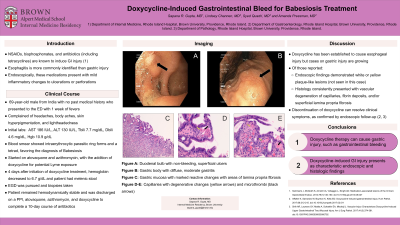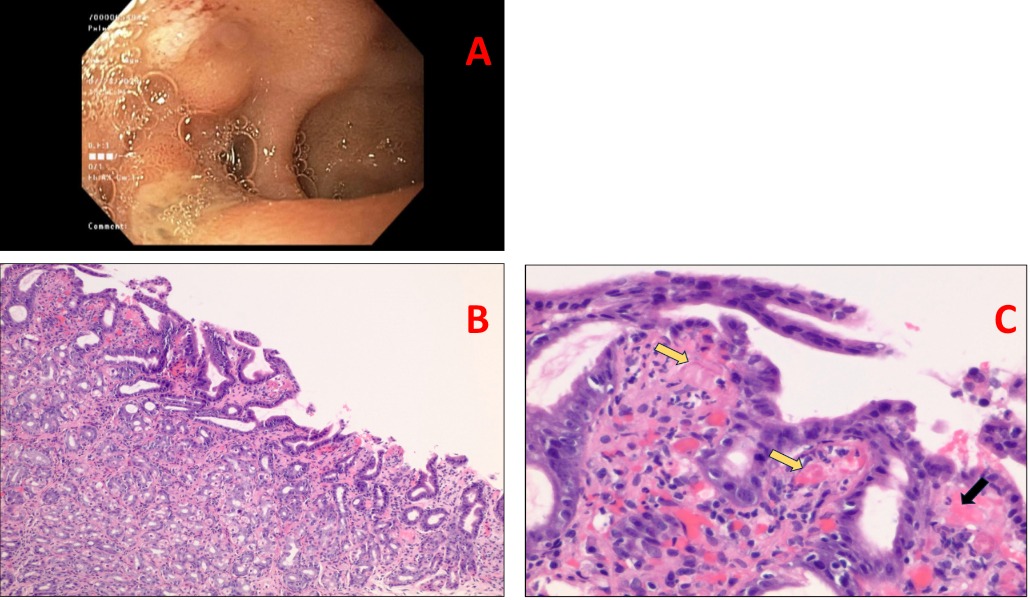Tuesday Poster Session
Category: GI Bleeding
P4241 - Doxycycline-Induced Gastrointestinal Bleed for Babesiosis Treatment
Tuesday, October 29, 2024
10:30 AM - 4:00 PM ET
Location: Exhibit Hall E

Has Audio

Sapana R. Gupta, MD
Brown University / Rhode Island Hospital
Providence, RI
Presenting Author(s)
Sapana R. Gupta, MD1, Lindsey Channen, MD2, Syed Quadri, MD2, Amanda Pressman, MD3
1Brown University / Rhode Island Hospital, Providence, RI; 2Brown Medicine/Lifespan, Providence, RI; 3Brown University / Warren Alpert Medical School, Providence, RI
Introduction: Several medications such as NSAIDs, bisphosphonates, and antibiotics (including tetracyclines) are known to induce gastrointestinal injury. Esophagitis is commonly seen, though pill-induced gastric injury is poorly characterized. On endoscopy, these medications present with mild inflammatory changes to ulcerations or perforations. In this report, we describe a case of gastrointestinal bleeding from biopsy-proven doxycycline-induced gastric injury.
Case Description/Methods: The patient was a 69-year-old male with no past medical history who presented to the ED with one week of fevers. Laboratory data was significant for: AST 186 IU/L, ALT 130 IU/L, total bilirubin 7.7 mg/dL, direct bilirubin 4.6 mg/dL, and hemoglobin 10.9 g/dL. A blood smear showed intraerythrocytic parasitic ring forms and a tetrad, favoring the diagnosis of Babesiosis without excluding Plasmodium falciparum due to recent travel history. The patient was started on atovaquone and azithromycin, with the addition of doxycycline for potential Lyme exposure. Four days after initiation of doxycycline treatment, the patient had a melenic stool and hemoglobin decreased to 6.7 g/dL. EGD revealed Grade A esophagitis without bleeding, gastritis with linear erosions and friability, and multiple, non-bleeding, clean-based duodenal ulcers (Figure 1A). Histopathology of random gastric biopsies revealed antral mucosa with erosive gastropathology and fibrinoid deposits within lamina propria capillary walls, consistent with doxycycline-induced gastric injury (Figure 1B-C). The patient remained hemodynamically stable and was discharged on a proton pump inhibitor and atovaquone, azithromycin, and doxycycline to complete a 10-day course of antibiotics.
Discussion: Doxycycline is known to cause pill-induced esophageal injury but data on gastric injury is growing. Some mechanisms that cause doxycycline-induced esophageal injury can be correlated to gastric injury. In addition, the difference in esophageal and gastric epithelium may be contributing to the more superficial reactive changes, as seen here, rather than deeper ulcerations typically seen in esophageal doxycycline injuries. Discontinuation of doxycycline has been shown to resolve clinical symptoms, as confirmed by endoscopic follow-up. In patients who are at high risk for gastrointestinal bleeding, alternative antibiotics may be considered. For those who are unable to select another antibiotic perhaps there is a role for protein pump inhibitor use as a protective mechanism.

Disclosures:
Sapana R. Gupta, MD1, Lindsey Channen, MD2, Syed Quadri, MD2, Amanda Pressman, MD3. P4241 - Doxycycline-Induced Gastrointestinal Bleed for Babesiosis Treatment, ACG 2024 Annual Scientific Meeting Abstracts. Philadelphia, PA: American College of Gastroenterology.
1Brown University / Rhode Island Hospital, Providence, RI; 2Brown Medicine/Lifespan, Providence, RI; 3Brown University / Warren Alpert Medical School, Providence, RI
Introduction: Several medications such as NSAIDs, bisphosphonates, and antibiotics (including tetracyclines) are known to induce gastrointestinal injury. Esophagitis is commonly seen, though pill-induced gastric injury is poorly characterized. On endoscopy, these medications present with mild inflammatory changes to ulcerations or perforations. In this report, we describe a case of gastrointestinal bleeding from biopsy-proven doxycycline-induced gastric injury.
Case Description/Methods: The patient was a 69-year-old male with no past medical history who presented to the ED with one week of fevers. Laboratory data was significant for: AST 186 IU/L, ALT 130 IU/L, total bilirubin 7.7 mg/dL, direct bilirubin 4.6 mg/dL, and hemoglobin 10.9 g/dL. A blood smear showed intraerythrocytic parasitic ring forms and a tetrad, favoring the diagnosis of Babesiosis without excluding Plasmodium falciparum due to recent travel history. The patient was started on atovaquone and azithromycin, with the addition of doxycycline for potential Lyme exposure. Four days after initiation of doxycycline treatment, the patient had a melenic stool and hemoglobin decreased to 6.7 g/dL. EGD revealed Grade A esophagitis without bleeding, gastritis with linear erosions and friability, and multiple, non-bleeding, clean-based duodenal ulcers (Figure 1A). Histopathology of random gastric biopsies revealed antral mucosa with erosive gastropathology and fibrinoid deposits within lamina propria capillary walls, consistent with doxycycline-induced gastric injury (Figure 1B-C). The patient remained hemodynamically stable and was discharged on a proton pump inhibitor and atovaquone, azithromycin, and doxycycline to complete a 10-day course of antibiotics.
Discussion: Doxycycline is known to cause pill-induced esophageal injury but data on gastric injury is growing. Some mechanisms that cause doxycycline-induced esophageal injury can be correlated to gastric injury. In addition, the difference in esophageal and gastric epithelium may be contributing to the more superficial reactive changes, as seen here, rather than deeper ulcerations typically seen in esophageal doxycycline injuries. Discontinuation of doxycycline has been shown to resolve clinical symptoms, as confirmed by endoscopic follow-up. In patients who are at high risk for gastrointestinal bleeding, alternative antibiotics may be considered. For those who are unable to select another antibiotic perhaps there is a role for protein pump inhibitor use as a protective mechanism.

Figure: Figure 1: A) Duodenal bulb with non-bleeding, superficial ulcers, B) Gastric mucosa with marked reactive changes with areas of lamina propria fibrosis, C) Capillaries with degenerative changes (yellow arrows) and microthrombi (black arrows)
Disclosures:
Sapana Gupta indicated no relevant financial relationships.
Lindsey Channen indicated no relevant financial relationships.
Syed Quadri indicated no relevant financial relationships.
Amanda Pressman indicated no relevant financial relationships.
Sapana R. Gupta, MD1, Lindsey Channen, MD2, Syed Quadri, MD2, Amanda Pressman, MD3. P4241 - Doxycycline-Induced Gastrointestinal Bleed for Babesiosis Treatment, ACG 2024 Annual Scientific Meeting Abstracts. Philadelphia, PA: American College of Gastroenterology.
